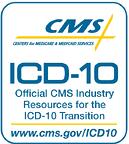ICD-10 Ready EHR
The transition to ICD-10 continues to challenge many physicians even despite the fact that CPT coding will remain unchanged. The most effective way to approach the implementation is to focus on high volume, high  revenue diagnosis codes. Identify these codes for your specialty, and then map the diagnoses from ICD-9 to ICD-10. Where do documentation requirements differ, and does your current documentation support the more specified code assignment?
revenue diagnosis codes. Identify these codes for your specialty, and then map the diagnoses from ICD-9 to ICD-10. Where do documentation requirements differ, and does your current documentation support the more specified code assignment?
Although each specialty will focus on different code changes, almost all physician practices must familiarize themselves with six basic ICD-10 concepts. This article explores those concepts to help physicians understand the type of new information that coders may seek to ensure accurate reimbursement, medical necessity, and data quality.
1. Disease type. Many ICD-10 diagnosis codes include additional detail regarding the type of disease. For example, COPD must be specified as emphysema, chronic bronchitis/asthma, acute exacerbation, decompensated, due to organic dust, organic, etc. Review your common diagnoses/disease types in ICD-10 to determine whether additional documentation is necessary.
2. Disease acuity. ICD-10 includes additional details regarding acuity. For example, in ICD-10, physicians must specify whether asthma is mild, moderate, or severe. Mild asthma must be documented as intermittent or persistent.
3. Disease stage. Many ICD-10 codes denote the specific stage of the disease. ICD-10 code L89.- is a good example. This code that denotes a pressure ulcer not only specifies stages 1, 2, 3, or 4, but it also denotes specific anatomical location and laterality. (Note: L89.- also provides the option of “unstageable,” meaning the stage cannot be clinically determined or the pressure ulcer is documented as a deep tissue injury but not an injury due to trauma).
4. Site specificity. Many diagnosis codes in ICD-10 include greater specificity to pinpoint the exact location of the disease or condition. For example, ICD-10 code I63.4- denotes cerebral infarction due to embolism; however, physicians must further specify where the embolism occurs (e.g., right middle cerebral artery, left anterior cerebral artery, right posterior cerebral artery, etc.), as this affects code assignment. Documentation must include the specific anatomical location.
5. Laterality. Many diagnosis codes in ICD-10 include descriptors that specify right vs. left vs. bilateral. For example, ICD-10 code C50.511 denotes malignant neoplasm of lower outer quadrant of right female breast. ICD-10 code C50.512 denotes malignant neoplasm of lower outer quadrant of left female breast. Note that the following diagnoses generally include laterality:
- Cancers
- Cerebral infarction
- Pressure ulcers
- Extremity atherosclerosis
- Arthritis
- Fractures
- Sprains
- Injury
- Joint pain
- Joint effusion
- Tears, meniscus, cruciate ligament
- Dislocations
Review ICD-10 codes for your most common diagnoses to determine whether their descriptions now include laterality as well.
6. Combination codes. ICD-10 includes many combination codes that capture diagnoses along with their associated manifestations, symptoms, or complications. For example, ICD-10 code E11.22 denotes type 2 diabetes with diabetic chronic kidney disease. ICD-10 code I25.110 denotes atherosclerotic heart disease of native coronary artery with unstable angina pectoris. ICD-10 also includes combination codes for poisonings and associated causes (e.g., ICD-10 code T42.3x2S to denote poisoning by barbiturates, intentional self-harm, sequela). Be sure to document the diagnosis as well as any of the underlying manifestations, symptoms, or complications so coders can capture the correct combination code.
Moving forward
By familiarizing themselves with these important ICD-10 concepts, physicians can proactively begin ICD-10 preparations. Review specialty-specific ICD-10 codes to determine whether any of these new concepts are applicable. Remember that certified coding professionals are a practice’s best asset and can often navigate through these changes.
For more information about how ICD-10 ready EHRs can improve the efficiencies in your office or to see a demo of RevenueXL’s EHR, contact Revenue XL today.
Related Posts:






